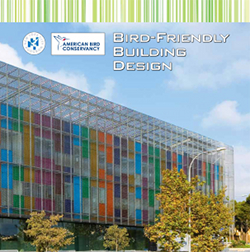
by Shane Henson — December 2, 2011—The American Bird Conservancy (ABC) hopes to inspire and assist architects and building owners to design buildings that are as safe for birds as they are for humans through the publication of American Bird Conservancy’s Bird-Friendly Building Designs.
The organization released the book as part of a national-level program to reduce the massive and growing number of bird deaths resulting from building collisions in the United States. Scientific studies have estimated that up to one billion birds die from building collisions in the United States each year, but the numbers may be higher, said Dr. Christine Sheppard, ABC’s building collisions campaign manager and author of the new guidelines.
“As new buildings are constructed each day across the country, architects, building owners, developers, and city planners need the direction this publication provides on how to make buildings safer for birds,” Sheppard said.
The 58-page publication contains over 110 photographs and 10 illustrations, and focuses on both the causes of collisions and the solutions, with a comprehensive appendix on the biological science behind the issue. The designs build on earlier efforts targeting local communities such as New York City, Chicago, and Toronto.
The publication examines the mirror effect of windows, glass transparency, the “passage effect” caused by dark glass, and the effects of external and internal building lighting, all of which lead to bird collisions. The book also addresses building design, bird movements, and habitat and landscaping, which can help or exacerbate the collision problem.
Just as important, the publication defines an ABC Bird-friendly Building Standard and also highlights legislative approaches to reducing collisions. In addition, it covers new construction ideas to improve building façades using different types of glass, nettings, screens, grilles, shutters, and exterior shades. Retrofitting of old buildings is also addressed, as are landscaping and lighting considerations that can be implemented in both new and old construction.




